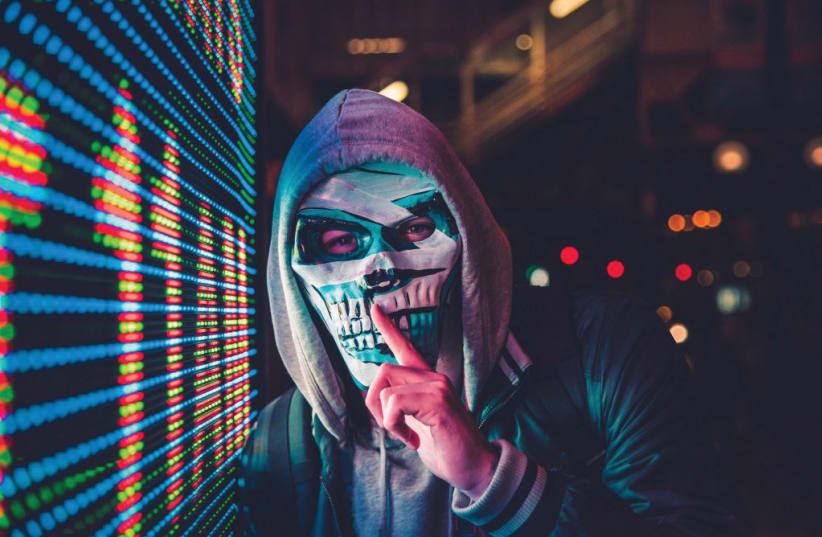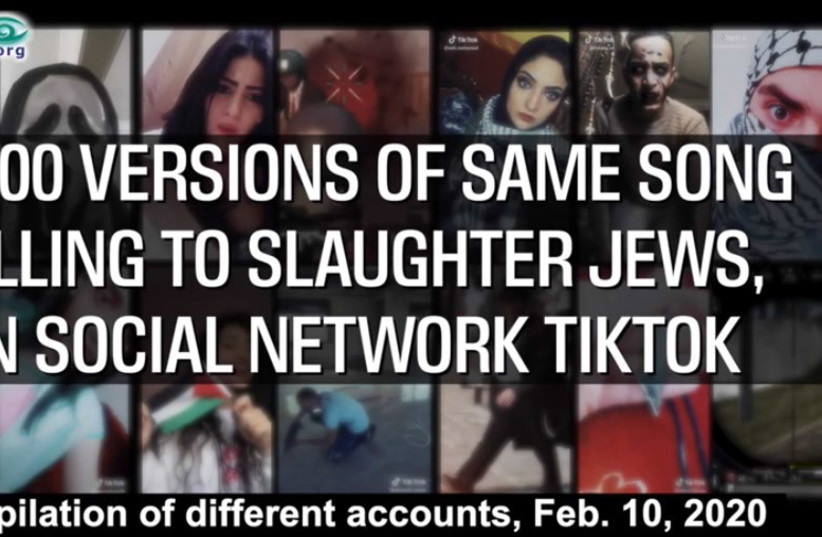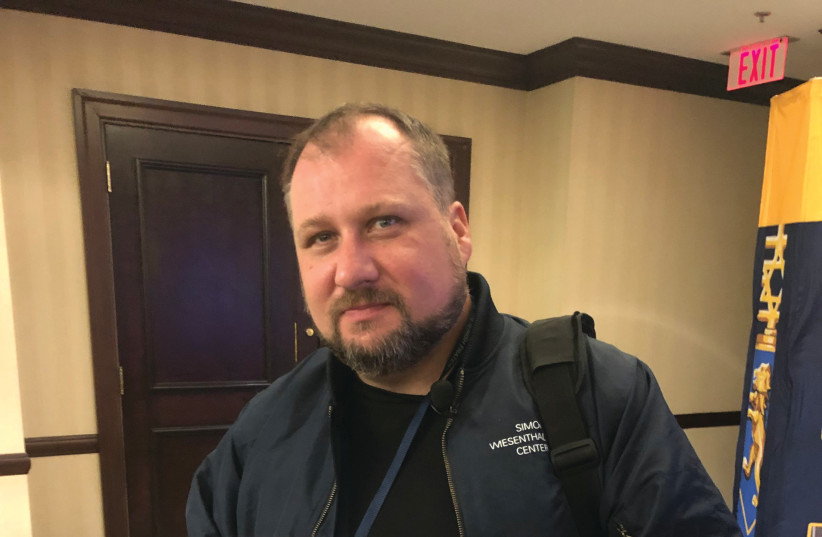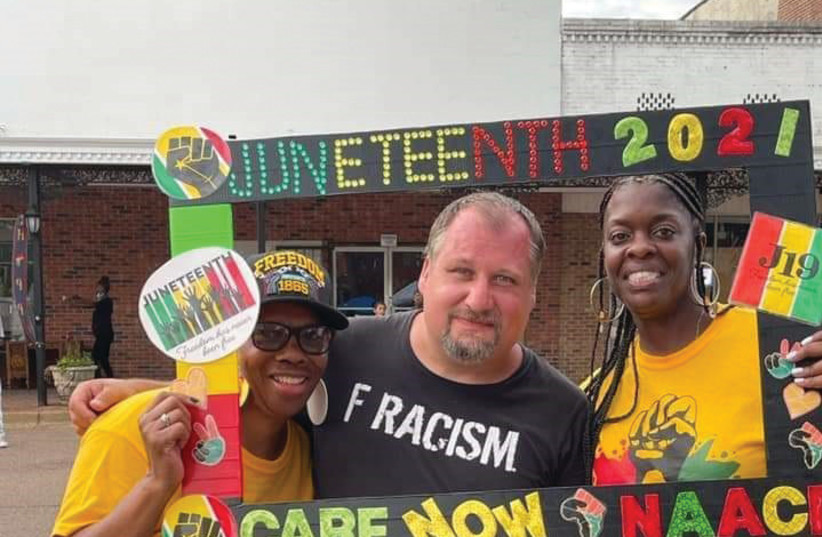During the first week of his sabbatical year abroad in Ottawa, Canada in 1984, University of Haifa Prof. Gabriel Weimann watched the trial of Ernst Zündel from his television. After just arriving to spend the year learning about antisemitism in the media, Dr. Weimann recalled, he watched the then-Canadian resident with a strong German accent contending from the walls of the Canadian courtroom that Auschwitz was not a death camp, and no Jews were exterminated there.
Zündel insisted that Auschwitz was an educational camp to teach Jews how to procure work, and the reason there was a fence around it, he connived, is not to keep the residents in, but to keep the many hopeful professionals out, who were vying to get into this highly desired vocational center.
“Either this guy is lying, or my mother, an Auschwitz survivor, is lying,” recalls Dr. Weimann. “Of course, I knew he was lying, but what about all the Canadians watching? Some of them don’t know about the Holocaust, as they don’t have a mother who came out of Auschwitz and survived,” he emphasizes.
Zündel was convicted for spreading hate and lies about Jews and the Holocaust and was eventually expelled from Canada. And Weimann is still researching antisemitism. But in the context of today’s internet and its ability to proliferate such hate messages exponentially, efforts to prosecute modern-day Zündels are virtually fruitless.
As large networks of people spread lies and hate through social networks 76 years post-Auschwitz, Dr. Weimann maintains, “not too many survivors can deny the deniers. The fight against messages online seems impossible.”
Weimann researches the spreading of antisemitic and hate messages online through the dark net and popular platforms such as TikTok, Facebook, YouTube and Twitter. A few years ago, with web intelligence analyst Ari Ben-Am, Weimann revealed a language that is used on social media by antisemitic groups, which often flies under the radar of artificial intelligence-designed algorithms.
The language is based on numbers, acronyms and hidden images in order to evade detection of language that is automatically removed from social media sites. Much of this coded language, the study found, was shown to rely on the use of “dog-whistles,” a coded message communicated through words or phrases commonly understood by a particular group of people, but not by others. It can be as simple as swapping one word for another such as far-right users calling Jews “Skypes,” African Americans as “Googles” and Latinos as “Yahoos,” says Weimann. Other tactics use numerology where numbers stand for people or concepts. For example, the number 88 stands for “Heil Hitler,” as H is the eighth letter in the alphabet. The language also employs visual cues by manipulating already popular memes found in pop culture, as an algorithm’s ability to detect hate speech within an image is limited.
Though proliferating exponentially today, this is not new – al-Qaeda used coded language to conceal its activities during the 9/11 attacks in place of words like the Twin Towers, Pentagon and White House.
Last year, presenting his findings of coded language that goes under the radar to representatives of TikTok, the company’s leadership personally promised Weimann (a vow that was recorded on BBC radio from London) that they would remove all such messages. So far, the promises have proven to be empty. “Not only was nothing removed, but there has been a sharp increase of 900-1000% in hate messages on TikTok.”
TikTok, Weimann suggests, is the most dangerous social platform as its 1.5 billion active user base is mostly represented by children and teenagers, the most impressionable age group. Dr. Weimann’s study reported “the disturbing presence of far-right extremism in videos, commentary, symbols and pictures,” including Nazi propaganda, misinformation, conspiracy theories and other nationalistic, fascist, racist, antisemitic, chauvinistic, nativistic, anti-immigration, anti-LGBTQ and xenophobic messages used for recruitment for violent incidents.
“Today there are thousands of Zündels, and nobody can stop and punish them, let alone identify them.”
So what to do about those who misuse today’s lightening-fast internet and its ability for access to instantaneous sources of hate?
“We cannot stop and say, let’s go back to the days of the cave. You cannot stop evolution, development and modernity. But can you harness the speed and development in a way that minimizes the damages and maximizes the advantages of the internet?”
The obvious way to minimize damage by removing the content is not always relevant because of the sophistication of new coded languages that bypass law enforcement agencies and hi-tech companies’ algorithms intended to stop hate. So, the way to immune viewers, Dr. Weimann poses, is to teach them to be critical viewers who are aware of fake news, lies, twisting of history and online hate.
Former Neo-Nazi and KKK member turned extremism researcher – a ‘convert’ in every sense of the word – and analyst at the International Center for the Study of Violent Extremism (ICSVE), TM Garret, believes that the answer to combating such extremism is through teaching to humanize through compassion.
Born and raised in a small protestant town in Germany, Garret grew up as a bullied child in a dysfunctional family and was looking for purpose and a sense of belonging. At 13 years old, discovering his masculinity in the schoolyard as many boys his age did, Garret learned to tell racist and Nazi jokes, but unlike his peers, he never grew out of the phase and was ‘put in a box’ labeled the “Nazi kid.” Though he said antisemitic things, his antisemitism was not intentional, states Garret, who did not even realize at the time that Nazis were anything but a thing of the past. But after assuming this label, another kid gave him ‘hate music’ that resonated with him, leading him to later join a far-right party in Germany and eventually forming like-minded connections in Europe.
“They presented it as civil rights for white people. They said we have a powerful and evil enemy who wants to destroy us and take over the world, and I can be a superhero who can save my people. I thought I was doing something noble. What kid doesn’t want to be a superhero? Give me a cape!” Garret quips.
Garret would end up staying in the movement, which he calls a “bubble,” for 15 years, full-heartedly believing that the Holocaust was a Jewish conspiracy and even boycotting certain companies that were “led by the enemy.”
As the white power movement grew in the 90s, and Garret began accessing the internet, the KKK movement in the US encouraged him to start his own KKK group, which he eventually did in 2000.
Confirming the findings in Weimann’s study, Garret affirms that numbers, codes and symbols are often used in extremist movements to subvert their recruitment and work. According to Garett, 88 is still used as “Heil Hitler” among Neo-Nazis, as well as the other code words. In addition, Garret says, Neo-Nazis use other code words like “the Benjamins” to represent Jews (because of the Jewish tribe and Benjamin Franklin on the $100 bill), and the OK sign to mean “white power” because it also looks like a W and P when one connects his or her thumb and index finger.
Using codes over physical force, Garret was instructed to keep his group non-violent. “We understood that if we were violent, we would go to prison and not achieve our goals, so our goal was to convince the population of our ideology so we would have the social approval and they would join us, like what happened in the Third Reich.”
Once approached by the police in 2002, Garret was confronted with the real possibility that he would be jailed if his members committed violent crimes. “I didn’t want to admit that my members could commit any violent crimes. We were telling them all the time not to. But I realized that I didn’t have them under control. We were not the hippies spreading peace and love – we spread a hateful message and dehumanized our enemies. We attracted people that maybe could have been ready to hurt people based on that, and I didn’t want to go to prison for this,” Garret explains, and he “retired as an antisemite” one year following 9/11. “I lost all my income that was connected to the movement and began to start over.”
Of course, he points out, leaving the movement did not de-radicalize him overnight. “You don’t only have to get your head out of the hate, but also get the hate out of your head. That’s two different things,” he explains.
Through getting to know his Muslim landlord and through “natural compassion,” Garret eventually realized that he had been ignorant and wrong. It took 10 years until he could fully face himself and truly examine all the lies, fear and hate associated with the KKK and Neo-Nazi movement.
Today, in his work as a researcher, he relates. “You can see the difference in how long it takes to radicalize without and with the internet. In 1988, it started on the school yard cracking antisemitic jokes… back then I had to smuggle in Mein Kampf into Germany, where it was outlawed, but now you can easily download a link and read it.”
Additionally, “recruitment is much easier these days,” Garret declares. “Before the internet, you would see a flyer or sticker, or go to a concert or some sort of ‘soft core entertainment’ to lure you in slowly. The soft-core hate would become more hard-core over time, but today, it is easier for extremists to recruit quickly, as the hate messages become uncontrollable, and moderation of media platforms becomes unmanageable.
Like Dr. Weimann, Garret maintains that the internet has lost the art of civil discourse and calls it both a “blessing and a curse.”
Today, Garret currently lives in the United States, where he is undergoing the Jewish conversion process. His first time attending Yom Kippur services was in 2019 on erev Yom Kippur. “I attended the Or Chadash Synagogue in Memphis for the very first time for the Kol Nidre service. The day when Jews around the world ask God for forgiveness for their sins. No other day could have been better for me for my first time,” he said.
At the services, the community asked him what antisemitism looks like today in Germany. Garret quelled their concerns and told them, “Germans are cool now, they did a good deal of reflecting and atoning, and I don’t think it’s a great danger anymore.” The next day, when he turned on his phone, he said, “I felt like a liar. A Neo-Nazi had shot up the synagogue in Halle.”
“As I was sitting and praying in the synagogue, I didn’t realize that someone could enter and shoot everyone. I too was sitting in the synagogue with a kippah on, praying in Hebrew. All of a sudden, I felt unsafe.”
But this fear that lives in minority groups, says Garret, could be challenged through empathy. He told the story of a Jewish university student in Michigan whose mezuzah was taken down and broken. The university’s cameras found the man who did it, and the police asked if she would be pressing charges against him. Instead, she asked to sit down with the young man, and asked him to join her in a visit to the Holocaust Museum, and he agreed. After admitting that he knew nothing about the Holocaust and did not understand the gravity of what he had done, he apologized and bought her a new mezuzah.
“Though there should be legal punishment for crimes, if a social punishment comes over and over again, that only aids radicalization and dehumanization,” Garret explains as the moral of the story.
“Today, around the world, people are ready to use violence against their neighbors because they dehumanize each other, call each other names like ‘racists’ and ‘baby killers,’ and is easier to use violence against a ‘racist’ or a ‘baby killer’ than against a ‘Jill’ or a ‘Jeff.’ We need to see the human behind the label,” urged Garret.
“If we bully someone out of town, even if they are antisemites, they will not forget what you have done to them. That will help them radicalize, and by not opening the ‘box’ that they’ve been put into, that makes us part of the problem, because we are dehumanizing them as well.
“When you see others as your fellow,” Garret continued, “you realize how great the commonalities are. How you pray, vote and love becomes secondary when the fear is gone.”
Some know it as the ‘Golden Rule,’ though Garret quoted Hillel the Elder, who said: “What is hateful to you, do not do to your fellow: this is the whole Torah; the rest is the explanation; go and learn.”






